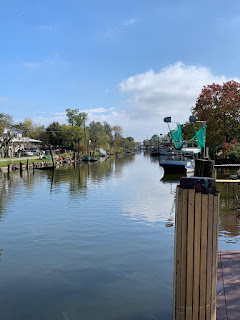Towards Awareness
A Photo-Journal:
For our November community day, we drove about 90 minutes south-west of New Orleans for a boat ride on Bayou Pointe-Aux-Chene, which resides along the Gulf of Mexico. On this boat ride, we heard and saw the tragic land-loss that is occurring rapidly along the Louisiana coast. In preparation for this day, we had read a book, Bayou Farewell, that does a really good job detailing both personal stories and scientific stats of this land-loss.
Unfortunately, due to the strong influence of oil companies, historical corruption of the Louisiana government, and national prejudices considering those who live in rural Louisiana to be "backwards," most of the country is ignorant concerning this impending environmental disaster.
What struck me most in the book, as well as from the experience of our guides, is that the environmental disaster is not slow or unnoticeable. They have memories from not so long ago where the land was tangible different than it is today.
"'When I was a kid,' Tee Tim says, 'I remember this canal being so much small that you could land your boat on solid ground right over there where that dead tree is. ... More than the sight of the tree, it's those five simple words that amaze me: 'When I was a kid...' It makes Tee tim sound like an old man looking back on a long lifetime. In reality he's seventeen, looking back maybe ten years. It's happening that fast." (p. 36)
 |
| The bayou is an integral part of the community. Boats are just as common, if not more so, a choice of transportation as cars. |
 |
| Many such shelters exist along the bayou so that during shrimping season, workers can rest or unload their boat at all hours when needed without having to take the time and energy to come ashore. |
 |
| Marsh grass holds together the soil that makes up the bayou. Chemicals and canals from oil companies cause this grass to die, thus the land sinks. |
 |
| This land once held multiple houses and livestock. The inhabitants had to leave because the land is no longer inhabitable. They had to leave the horses behind, who now graze wildly. |
 |
| A Native American cemetery used to exist along this land. Though it is now unrecognizable as a cemetery, the community placed a large cross to identify and commemorate what it once was. |
 |
| Once fostering a healthy and robust ecosystem, the trees that grew in the bayou are clearly dead or dying. |
 |
| Our guides told us how in their childhood, they could touch the grass along both sides of the boat. |
 |
| This is how wide that bayou is now. Obviously grown much wider than it was before. |
 |
| These telephone lines were originally built on solid land. |
 | |
|
 |
| I just thought that Nate looked regal in this picture. |
 |
| Me and my roommate, Sarah, being cute. (She took the majority of the photos on this blog.) |
 |
| A special thanks to our guides, Donald and Theresa, who are members of the Pointe-Au-Chien native community. Their memories really helped us visualize how the bayou has changed over their lives. |
At the end of the day, I reflected on the irony of the fact that New Orleans is the only YAV site where volunteers are allowed to bring their cars, yet it is so close to the environmental destruction caused by oil companies pumping oil for fuel.
How can I, how can we as a YAV site, how can we as a society do a better job stewarding the earth?
God's first task for us as humans was to take care of the land.
The Lord God took the man and put him in the Garden of Eden to work it and take care of it.
Genesis 2:15
We need to take care of God's earth.


Comments
Post a Comment